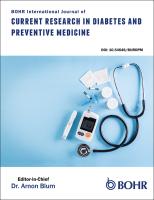Diabetic Cardiomyopathy: An Update on Its Pathophysiology With
Specific Emphasis on Epigenetics Modifications Besides
Treatment – A Systematic Review
BOHR International Journal of Current Research in Diabetes and Preventive Medicine (BIJRDPM), 1 (1):
1-16 (October 2022)DOI: 10.54646/bijrdpm.001
Abstract
Diabetes mellitus (DM) represents a significant lifestyle disease. Of the types of DM, type 2 DM aids maximum in the development of cardiovascular disease (CVD) along with diabetic cardiomyopathy (DbCM), which is correlated with significant mortality along with comorbidity in diabetic patients. DbCM is a non-canonical cardiac illness that exhibits cardiac remodelling occurs when there is DM but not when there is any concomitant conditions like hypertension, valve disease, or coronary artery disease (CAD). DbCM is linked to altered mitochondrial structure and function, as well as aberrant cardiac metabolism. Additional physiological and pathological signaling mechanisms include inflammation, oxidative stress (OS), and others; besides, in the diabetic environment, there are various cardiomyopathy-inducing factors such as reactive oxygen species (ROS)-modulated OS, hyperglycemic situations, cytokines-modulated These mediators induce inflammatory responses, cell death, including apoptosis, pyroptosis, and autophagy, as well as the epigenetic control of abnormal molecular pathways. The last ten years have demonstrated the importance of miRNAs and long noncoding RNAs (lncRNAs) in controlling key biological processes such cell death, mitochondrial dysfunction, and electrical remodelling. Cardiomyopathy is a significant event regarding cardiac remodeling event in DbCM. Considerable proof exists regarding the part of epigenetics in diabetic correlated cell demise. Epigenetic controlling modes like histone alterations, DNA methylation, and miRNA along with lncRNAs control cardiac cell demise in the diabetic environment. Akin to that, other modes such as mitochondrial impairment and OS are controlled by miRNA along with lncRNAs. Finding these modes has given provision of generation of innovative therapy approaches for DbCM. miRNAs along with lncRNAs have illustrated translational capacity in the form of Besides treatment options, There are other DbCM-specific diagnostic and prognostic biomarkers available. HDACs were further shown to have a crucial role in controlling the pathogenesis of DbCM.
